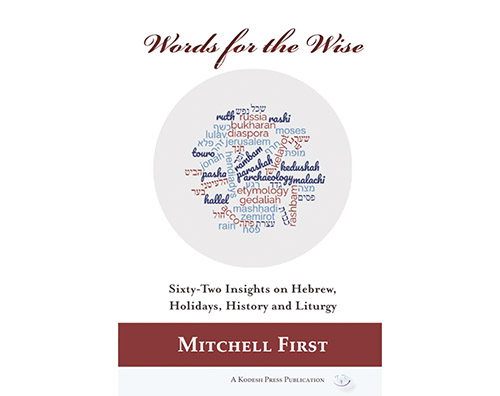
Reviewing: “Words for the Wise: Sixty-Two Insights on Hebrew, Holidays, History and Liturgy” by Mitchell First. Kodesh Press. 2022. 264 pages. ISBN-13: 978-1947857971.
There was great anticipation as the news spread that Mitchell First had a new book coming out soon. It arrived and I was not disappointed. Again a tour de force by the author who is a personal injury attorney and, it seems, spends more time as a Torah academic, inquiring and writing about topics related to a rich variety of Judaic subjects.
This is his fifth book. Like his third and fourth books (“Roots and Rituals,” 2018, and “Links to Our Legacy,” 2021), this is a collection of over 60 articles first published in this paper. The articles are all improved from their earlier versions.
The author’s first book, published in 1997, was an improved version of his master of arts’ paper at Bernard Revel Graduate School. It dealt with one topic: the unusually short Jewish chronology of the ancient Persian period. His second book was “Esther Unmasked: Solving Eleven Mysteries of the Jewish Holidays and Liturgy.” It consisted of 11 long articles, many of which were published previously in the journal Hakirah.
His first book was published by Jason Aronson publishers, which at the time was a leader in the field of Jewish publishing. His last four have been published by Kodesh Press, which in the last few years has made its own mark in the field, publishing important books by Rabbi Hayyim Angel, Rabbi Amnon Bazak, Rabbi Yamin Levy, Rabbi Bezalel Naor, Dr. Moshe Sokolow and many others.
As the title of First’s new book indicates, it is a rich collection of 62 articles: multifaceted inquiries relating to our cycle of Jewish life. For example, at this time of the year we recite “Le-David Hashem Ori,” and the article probes the origin of this minhag, and issues surrounding it. Until recent decades it had been widely believed that the controversial work “Chemdat Yamim” (1731) was the earliest source for our recital custom. But First explains that it has now been determined that the earliest source for our recital custom is the work “Shem Tov Katan” from 1706 by a kabbalistic rabbi from Poland. After reading First’s essay, you walk away informed, with a whole new understanding of our custom to recite this psalm.
In the balance of the section dealing with the holidays you will find inquisitive articles relating to “Tzom Gedaliah,” the concept of “Inui Nefesh” of Yom Kippur, and etymologies and comprehensive understandings of the words “lulav,” “Atzeret” and “Pesach.” The author has the ability to explain difficult concepts in a simple and coherent way, and quote the main relevant traditional sources and academic sources on a topic. And no spoiler intended, but most articles end with a humorous comment.
In the “Liturgy” section there are fascinating articles dealing with Anim Zemirot, the Shalom Aleichem prayer, praying for rain in Birkat Ha-Shanim in different climates, Maoz Tsur, and many more. The “History” section covers historical topics across the span of time. In ancient Jewish history, topics such as the history of the city of Acco, the Urim ve-Tumim, and Moshe’s raised hands at Exodus 17:9-12 are explored. In more recent history, topics such as the story of the Mashhadi Jews of Iran and “Insights into Jewish Names and Modern Israel” are examined. This section also includes a number of biographies relating to different people including Rashbam, Judah Touro, Golda Meir, Yigael Yadin and James McDonald (the first U.S. Ambassador to the State of Israel).
The longest section (and the one I always learn the most from) is the category covering Hebrew roots. It comprises 27 articles. For example, an article regarding the etymology of mavet (death), the three meanings of the root זמר, and the multiple meanings of the root רגע. There are a few articles dealing with difficult words and phrases in Tanach like the prohibition of “Lo Titgodedu,” the distance measure “Kivrat Ha-Aretz,” and the meaning of Joseph’s “Ketonet Pasim.” This section also includes an article relating to interesting words in Hallel. As many of the articles are appropriate for parshiyot throughout the year, the book provides a guide to read the articles by parsha.
The book is a treasure trove on diverse topics that each reader will find much to relate to and learn from. First has again provided us with a unique book in so many ways. It is easy to read, even as it is filled with sources, analysis of these sources, and comprehensive research. Once again he has pushed ahead the boundaries of intellectual honesty and Jewish scholarship, making this book a “must have” for those who yearn to learn more about our customs, language and heritage.
By Rabbi Abraham Lieberman












